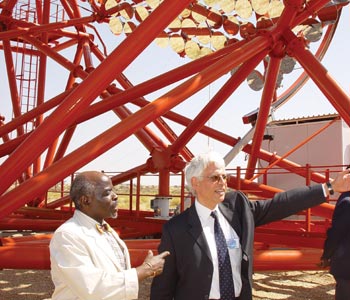
The first telescope of the high-energy stereoscopic system (HESS), named in honour of Victor Hess, the discoverer of cosmic radiation, was officially inaugurated in Namibia in September. HESS is a system of large Cerenkov telescopes intended for high-energy gamma-ray astrophysics.
The HESS collaboration identified the Gamsberg area of Namibia as an ideal location for a high-energy gamma-ray observatory in January 1998. With the support of the Namibian government and local landowners, construction began in 1999. HESS was originally conceived as a two-phase project, with four telescopes being installed in the initial phase and a further 12 identical telescopes being added later. The first telescope began operation this summer, with phase one scheduled for completion by 2004. Options for phase two are currently being studied.
The physics motivation behind HESS is to pinpoint the origins of high-energy cosmic rays through the study of cosmic gamma rays from around 100 GeV to several TeV. Although Hess began the work that led to the discovery of cosmic rays in 1911, there is still very little known about their origins. The majority of primary cosmic rays are atomic nuclei, whose trajectories through space are influenced by interstellar and intergalactic magnetic fields. Such fields, however, do not affect gamma rays, and so their detection will point right back to the source.








